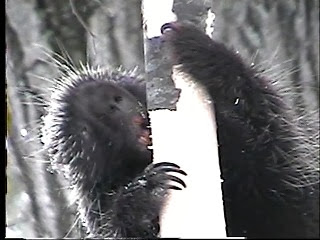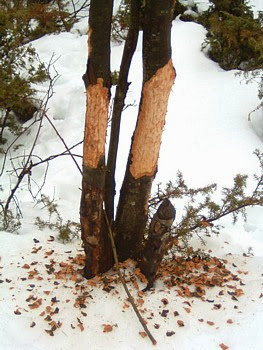Meanwhile, just as I have for 20 years, I still see the active dens of porcupines in all the ridges between the ponds. Porcupine dens can be easy to spot in the winter.
Porcupine trails in the snow lead you right to them and sometimes you catch the porcupine not quite safely inside.
For years I've watched both beavers and porcupines and when I saw each animal gnawing trees, I fancied that there had to be a brotherhood of such earnest bark eaters, one felling trees and the other climbing into them, had the same take on life though one was wet and the other dry.
There is a high granite ridge north of a string of ponds that used to host beavers. In the fall, I'd sometimes sit up there to look for beavers, scoping out fresh gnawing near the ponds if I couldn't see a beaver swimming in them. Usually fresh bark stripping by porcupines in the tall trees right in front of me framed the photos of the gnawing below.
The beavers coming out of their lodge in the pond and might go foraging up the slope almost to the rock den where the porcupine lived. The porcupine coming out of its den might climb up the slope and climb the tall trees higher up on the ridge that the beavers can't girdle.
Nice way to split the universe.
When I joined the porcupine and beaver in brotherhood, it was half tongue and check since I had long celebrated the earth changing virtues of the beavers. No one ever called porcupines a keystone species.
Then the beavers I watched started moving out and other beavers didn't move in to replace them. The earth changer cycled itself out of the picture. The crown trimmer survived.
It's easy to broaden your view of the comings and goings of animals when you read about it in books. It's another matter when you've become accustomed to watching them and they are gone.
Perhaps by analyzing why the dry beavers, the tree climbers, the porcupines survive so much longer, we can learn something about beavers.
In a nutshell, these seem to be the factors: the porcupine is smaller save for its claws, social in a prickly way and less prolific.
Porcupines sometimes come down to beaver ponds to get a drink and on May 15, 2003, I got a good photo of that.
A wet beaver that size would be considered small. Those porcupine quills are not wet and the skin of the animal is a few inches below the sharp points of the spines.
The lightness of porcupines is better measured when they are high in a tree.
And they always take you higher:
But in a fashion beavers can climb trees.
Once I saw a beaver fall from such a perch but this beaver made a not inelegant dive:
One winter I found clear evidence of a beaver climbing rather high on a half downed red oak still up at about a 20 degree angle.
That's my wife under the tree and she's no midget.
Of course, beavers can't really climb trees because they don't have claws like porcupines.
Once I got a memorable photo of a porcupine climbing a tree showing the cut of its teeth and claws.
Beavers have their own way of getting into the crowns of trees: cut the tree down.
The beaver doesn't have claws like a porcupine, but a porcupine doesn't have jaws like a beaver. And thanks to its much bigger jaws, the beaver's bite is much bigger.
It might be more scientific to share measurements of skulls, but it might be more memorable to share photos of a porcupine likely killed by a fisher and a beaver perhaps killed by a bobcat.
The photo of the beaver skull, fished out of the Deep Pond at my land, doesn't even show the lower jaw, but the gap between the incisors and the molars is considerable. The porcupine's incisors clearly don't have such reach.
Here are the skulls side by side:
Looking at the massive beaver jaw, it's easy to see why beavers cut down trees. (I hesitate to say that beavers evolved to become tree cutters, because the jaw of the muskrat has the same design. Both are aquatic mammals and I think their jaws primarily designed to bring up and eat the underwater roots and rhizomes of aquatic plants.)
Looking at the jaws of a porcupine it's easy to see that it wouldn't have enough bite to waste time trying to cut down a tree, though it does cut off some branches. It seems designed less for gnawing like the beaver's incisors and more for scraping off bark.
Not that porcupines can't do a number on trees. They have sometimes startled me with the extent of their gnawing, like this completely stripped white oak that I saw on December 31, 2011,
Can't blame that porcupine for getting carried away. But generally porcupines with their smaller teeth gnaw elliptical patches up tree trunks.
Sometimes I see freshly gnawed ellipses next to old ones.
Sometimes I get the impression that a porcupine has bonded with a tree, that it periodically milks it over the years.
Trees can survive such wounds. And in the spring, porcupines feast on the budding twigs and catkins high in the crown.
One fine day in May, I got a video of a bud-obsessed porcupine who seemed to literally put the spring into spring.
Porcupines also commonly sleep high in tree during the day.
I got a video one August of a porcupine waking up as the sun went down conveniently surrounded by thick leaves to munch. Not for nothing is it sometimes hard to see porcupines in the late summer. Why leave that arboreal paradise?
But I hesitate to say that there is some innate sense of conservation in porcupines, that they purposely pattern their foraging to increase a tree's chance of survival. They are simply smaller and have a more modest appetite than a beaver. Trees can usually endure porcupines.
In my experience, only in harsh winter conditions are porcupines likely to girdle a tree.
A valley in some land I own is a hotbed of porcupine activity. Beavers were there for a few years then moved on. So for a period of time, I could fancy I was a tree and ask myself which plant predator I preferred.
Hemlocks are the pride of the valley. Porcupines love them sometimes to death even though they seldom gnaw bark off the trunks. They keep trimming branches until their are no branches left.
I didn't think beavers cared much for hemlocks and thought some small ones cut down were simply the results of a few errant beaver gnaws.
I was wrong. When the beavers fashioned a pond beside a grove of hemlocks, they began cutting down bigger trees
And then the beavers began stripping the bark off the larger hemlocks.
I think the beavers got into the habit of stripping the hemlock bark and using it for their bedding inside the lodge. Anyway they cut or girdled just about all the mid-sized to small hemlocks.
Needless to say all those hemlock died. I can take a larger view of that. Thinning a stand of hemlock generally increases biodiversity. And I looked forward to the beavers fattening themselves on the grasses and shrubs that would now grow along that shore, but the beavers left.
There were still plenty of large hemlock a bit higher up on the ridge. Last time I hiked down the valley, a snowy morning in January 2014 three years after the beavers left, I saw porcupine trails under the hemlocks:
The sharp quills of the porcupine make it like no other animal. Beavers feast on grasses and so do porcupines. The beaver can't go far from its pond.
The porcupine can dine in the middle of a golf course fairway.
Plus those same quills that protect a porcupine from other animals seem to keep porcupines from getting close to each other which can keep a stand of trees from being overwhelmed by crown trimmers and bark scrappers. I rarely get photos of porcupines close together and at first glance the one below shows two remarkably close.
But they are on different trees. Such is the porcupine's lonely trajectory through life. To be sure, I have seen porcupines on the same limb, but there is no better emblem of mutual discomfort.
Plus those two were screeching at each other. Seeing beavers together, especially in the winter, invariably warms me.
Porcupines together usually means screeching if not a fight:
Any animal that grazes on the ground or up in trees makes an impact on surrounding vegetation, but that impact is minimized when the animal generally grazes alone. To be sure porcupines mate and have off spring but usually just one baby porcupine.
I have often observed the exertions of beaver parents to feed their young. Once I was up on a ridge watching two kits swimming a bit aimlessly around the lodge. Then an adult beaver swam down to them and turned toward the ridge and climbed straight up coming within a few yard of me. It cut down a small tree behind me, cut off one of the branches and dragged it down to the kits who started eating the leaves. Meanwhile I heard something else crawling behind me. It was a porcupine, alone as usual. It stopped when it saw me and went on its lonely way. Too dark for a good video.
I did get a video of baby porcupine with its mother, characteristically walking away.
Let me note that in response to a threat, me in this case, mothers and babies of many species separate. But this separation was so slow, I wonder if they thought I was a threat.
By winter, as far as I've been able to tell, all porcupines will be alone. No need for caching branches or other food, like beavers and other animals do.
My passion for beavers is evident and I have been woefully slow in observing how they change the land let alone understanding it. So all credit to the beavers, but there is something god-like about a porcupine.
If I was going to make a religion of my nature watching, I would find the Church of the Porcupine accessible and easy to find and if the little god wasn't inside, I might see It high in a nearby altar, and, if high enough, It invariably beams down on me Its prickly blessing, a soothing balm for an old man like me.








































No comments:
Post a Comment